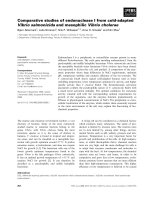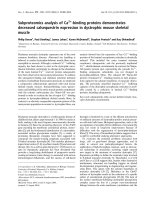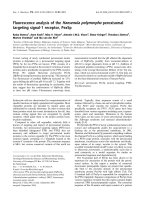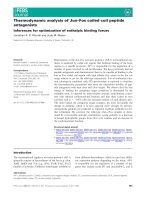báo cáo khoa học: " Comparative analysis of slot dimension in lingual bracket systems" pps
Bạn đang xem bản rút gọn của tài liệu. Xem và tải ngay bản đầy đủ của tài liệu tại đây (1.2 MB, 5 trang )
BioMed Central
Page 1 of 5
(page number not for citation purposes)
Head & Face Medicine
Open Access
Research
Comparative analysis of slot dimension in lingual bracket systems
Anton Demling*, Marc P Dittmer and Rainer Schwestka-Polly
Address: Department of Orthodontics, Hannover Medical School, Carl-Neuberg-Strasse 1, 30625 Hannover, Germany
Email: Anton Demling* - ; Marc P Dittmer - ; Rainer Schwestka-
Polly -
* Corresponding author
Abstract
Background: Orthodontic treatment with fixed appliances requires - among others - the correct
clinical expression of torque, which depends on the precise fitting of archwire and slot. Especially
in the lingual technique torque problems become clinically more evident than in labial appliances
also with respect to the vertical alignment of teeth due to different distances from the center of
resistance. The purpose of the present study was to compare the preciseness of slot dimensions
of different lingual bracket systems.
Methods: Three lingual bracket systems were included in the study (7
th
Generation and STb,
Ormco, Glendora, CA, USA; Incognito, TOP-Service/3 M Unitek, Monrovia, CA, USA). Non
destructive analysis of vertical slot dimensions was performed using precision pin gauges (Azurea,
Belprahon, Switzerland) that were tapered in increments of 0.002 mm (0.00008 inch). The sizes of
240 incisor and canine brackets were measured per system (total: 720). Data were compared using
one-way ANOVA. A p-value < 0.05 was considered statistically significant.
Results: Average slot dimensions were 0.467 mm ± 0.007 mm (0.0184 inch ± 0.0003 inch) for the
7
th
Generation bracket system, 0.466 mm ± 0.004 mm (0.0183 inch ± 0.0001) inch for the STb
bracket system and 0.459 mm ± 0.004 mm (0.0181 inch ± 0.0001) inch for the Incognito bracket
system. Differences between systems were statistically significant (p < 0.05).
Conclusions: The analyzed bracket systems for lingual treatment exhibited significant differences
in slot dimension that will clinically result in torque play. These aspects must be considered in
lingual orthodontic treatment.
Background
In recent years, an increased number of adult orthodontic
patients have sought the correction of malaligned teeth.
These patients are frequently focused on dental esthetics
in the anterior region. For socio-cultural reasons, adult
patients favor invisible orthodontic treatment over eye-
catching treatment by buccal appliances. Hence, fixed lin-
gual bracket systems have been developed over the last 30
years [1-4]. Due to the large bucco-lingual dimension of
these prefabricated bracket systems, these systems were
reported to cause clinical problems, such as speech dys-
function as a result of restricted functional space for the
tongue, oral discomfort due to injury or irritation of the
tongue, and restriction of mastication [5-7]. The imple-
mentation of customized lingual brackets and computer-
ized archwire fabrication resulted in a decrease of
subjective impairments [8-10]. Thanks to clinical simpli-
fication in using customized appliances, the indication for
Published: 15 December 2009
Head & Face Medicine 2009, 5:27 doi:10.1186/1746-160X-5-27
Received: 25 September 2009
Accepted: 15 December 2009
This article is available from: />© 2009 Demling et al; licensee BioMed Central Ltd.
This is an Open Access article distributed under the terms of the Creative Commons Attribution License ( />),
which permits unrestricted use, distribution, and reproduction in any medium, provided the original work is properly cited.
Head & Face Medicine 2009, 5:27 />Page 2 of 5
(page number not for citation purposes)
lingual orthodontics has been extended to adolescents
[11].
Besides visibility of the appliance during orthodontic
treatment, the labio-lingual inclination of maxillary and
mandibular incisors and canines is considered by patients
and orthodontists to be an important determinant in pro-
viding esthetic outcome after orthodontic treatment. Fur-
thermore, the correct inclination of the anterior teeth is
essential in providing good occlusion in anterior and pos-
terior regions, and is basically dependent on the correct
expression of torque. This torque expression can be
achieved by using slot-filling archwires or twisting and
inserting undersized archwires. Nevertheless, various fac-
tors affect the correct torque expression of a preadjusted
appliance [12]. These factors include material properties
such as hardness and modulus of elasticity of the archwire
and bracket, variations of manufacturing processes
including milling and casting of brackets, as well as clini-
cal procedures like mode of ligation [13,14]. Furthermore,
a patient's individual tooth morphology also influences
the clinical outcome of torque [15,16]. In the literature, it
was shown that oversized slots lead to a clinically relevant
torque loss [17]. Due to the longer lever arm in lingual
orthodontics, slot precision must be considered as a key
factor that influences tooth position not only in the labio-
lingual but also in the vertical dimension [18] (see Figure
1).
Therefore, the aim of this study was to evaluate the slot
precision of frequently used lingual appliances.
Methods
Three lingual bracket systems were included in the study:
7
th
Generation (Ormco, Glendora, CA, USA), STb
(Ormco) and Incognito (TOP Service/3 M Unitek, Monro-
via, CA, USA). All brackets were manufactured with a slot
dimension of 0.457 mm (0.018) inch. For each system,
the sizes of 240 incisor and canine bracket slots were
measured (a total of 720). Non-destructive analysis of
0.018 inch slot dimensions was performed by one opera-
tor using precision pin gauges (Azurea, Belprahon, Swit-
zerland). Pin gauges were tapered in increments of 0.002
mm (0.00008 inch), Figure 2.
Measurements of slot precision were performed starting
with the insertion of the smallest pin gauge with a dimen-
sion of 0.456 mm (0.01795 inch), Figure 3. Consecutive
insertion of pin gauges was continued until the bracket
was attached to the pin gauge by friction (Figure 4). The
value of the pin gauge one increment below the finally
inserted one was documented as slot size.
Power and sample sizes were calculated using nQuery
Advisor 5.0 (Statistical Solutions, Saugas, Massachusetts,
USA). Power calculation revealed that the ANOVA F-test
with a sample size of 240 would have a 90% power to
detect a difference in means of +0.00254 mm (+0.0001
inch) and -0.00254 mm (-0.0001) inch to a reference
group, assuming a within-group standard deviation of
0.01524 mm (0.0006 inch). Documentation and evalua-
tion of the data was performed using the Statistical Pack-
age for the Social Sciences, Version 17.0 for Windows
(SPSS, Chicago, Illinois, USA). The Kolmogorov-Smirnov
test was applied to test for normal distribution. As data
were distributed normally, they were compared using
one-way ANOVA. Post-hoc testing was performed with
the Fisher's LSD test. All tests were performed two-tailed
with a significance level of α = 0.05.
Results
Results of experimental measurements are presented as a
boxplot in Figure 5 and in Table 1. Average slot dimen-
sions were 0.467 mm ± 0.007 mm (0.0184 inch ± 0.0003
inch) for the 7
th
Generation bracket system, 0.466 mm ±
Effects of torque lossFigure 1
Effects of torque loss. Comparison of torque loss (-15
degrees) in lingual and buccal technique with respect to verti-
cal side effects (CR = Centre of Rotation).
Pin gaugesFigure 2
Pin gauges. Precision pin gauges tapered in increments of
0.002 mm (0.00008 inch).
Head & Face Medicine 2009, 5:27 />Page 3 of 5
(page number not for citation purposes)
0.004 mm (0.0183 inch ± 0.0001 inch) for the STb
bracket system and 0.459 mm ± 0.004 mm (0.0181 inch
± 0.0001 inch) for the Incognito system. The calculated
medians for the included lingual bracket systems were
0.4660 mm (0.0184 inch) for the 7
th
Generation and the
STb bracket and 0.4580 mm (0.0180 inch) for the Incog-
nito bracket. Statistical analysis revealed significant differ-
ences in slot precision between all analyzed bracket
systems, with the highest precision for the Incognito
bracket and the lowest for the 7
th
Generation bracket (p <
0.001).
Discussion
The clinical expression of torque can be achieved by
inserting archwires with gradually increased dimensions.
However, due to undersized archwire dimensions, edge
bevelling and oversized slot dimensions, a significant play
of the archwire in the slot can be observed [19-21]. These
factors result in a clinically relevant torque loss.
Therefore, the literature describes various methods for the
determination of slot precision. For example, a metallur-
gic method was used to measure bracket slot height in
stainless steel brackets after preparation of cross-sectional
cuts through the bracket slot [22]. Afterwards, the slot
height was measured to the nearest 0.01 mm with a Zeiss
Axioscope. This method was characterized by destructive
analysis of brackets, considerable technical effort, and low
accuracy. Consequently, methods were improved by esti-
mating effective slot height by using a formula that
describes the relationship between bracket slot height,
wire dimensions, wire edge bevel and torsional play [17].
This method has the advantage of high precision and non-
destructive analysis, but again requires great technical
effort. To allow determination of slot precision in large
samples with a high degree of accuracy, measurements in
the present study were performed by use of high precision
pin gauges. The applied increments of 0.002 mm
(0.00008 inch) can be considered as very finely gradu-
ated. The application of manual measurement further-
more allowed non-destructive analysis, and was therefore
associated with low costs.
The standards for the precision of orthodontic attach-
ments in Germany are defined in DIN 13971-2. According
to this standard, a 0.0018 inch slot should have a slot
width between 0.0018 inch (0.46 mm) and 0.00197 inch
(0.50 mm) [23]. In the present investigation, all lingual
bracket systems fulfilled these requirements, with meas-
ured average slot precisions between 0.0181 inch for the
Incognito bracket and 0.0184 inch for the 7
th
Generation
bracket.
However, significant differences in slot precision were
found between all investigated bracket systems. The
extremely high accuracy of the Incognito bracket can be
explained by the manufacturing process. All Incognito
brackets undergo subsequent manual measurement of
slot precision [8]. Therefore, the tolerance range of slot
dimension guaranteed by the manufacturer is 0.0180 inch
to 0.0183 inch.
Although the other two brackets fulfilled the DIN stand-
ard, the clinical implications of torque play must be care-
fully considered. The correct buccolingual inclination of
maxillary teeth is particularly critical in establishing an
esthetic smile line, proper anterior guidance, and a Class I
canine and molar relationship [24]. One study showed
that an additional anterior inclination of 5° generates 1
mm of additional arch length [25]. Consequently, the cor-
rect clinical expression of torque can be regarded as a key
Start of measurementFigure 3
Start of measurement. Start of measurement of slot pre-
cision by insertion of the smallest pin gauge with a dimension
of 0.456 mm (0.01795 Inch).
End of measurementFigure 4
End of measurement. Measurement of slot precision
ended when the bracket was attached to the pin gauge by
friction.
Head & Face Medicine 2009, 5:27 />Page 4 of 5
(page number not for citation purposes)
factor for successful orthodontic treatment, but which is
mechanically jeopardized in lingual orthodontics by the
longer lever arm [18]. As the Incognito bracket is a cus-
tomized bracket, it has a shorter lever arm than the other
two lingual bracket systems. This factor must be regarded
in addition to the significant differences in slot precision
when determining the clinical performance of lingual
bracket systems with respect to the clinical expression of
torque.
Conclusions
In the present study, all investigated lingual bracket sys-
tems fulfilled the DIN 13971-2 standard with average slot
sizes of 0.467 mm (0.0184 inch) for the 7
th
Generation
bracket system, 0.466 mm (0.0183 inch) for the STb
bracket system and 0.459 mm (0.0181 inch) for the
Incognito system. However, slot precision differed statisti-
cally significantly between all evaluated bracket systems.
Competing interests
The authors declare that they have no competing interests.
Authors' contributions
AD performed measurement of slot dimensions, statistics
and wrote major parts of the manuscript. MPD assisted in
performance of statistics and wrote parts of the manu-
scripts. RSP conceived the study design and participated in
preparation of the manuscript including interpretation of
data. All authors read and approved the final manuscript.
Acknowledgements
We would like to thank Prof. Dr. em. H. Hecker, Institute of Biostatistics,
Hannover Medical School for assistance with statistical analysis. Further-
more we thank Mrs. S. Robra for the illustrations.
References
1. Fujita K: New orthodontic treatment with lingual bracket
mushroom arch wire appliance. Am J Orthod 1979, 76:657-675.
2. Alexander CM, Alexander RG, Gorman JC, Hilgers JJ, Kurz C, Scholz
RP, Smith JR: Lingual orthodontics. A status report. J Clin Orthod
1982, 16:255-262.
3. Kurz C, Swartz ML, Andreiko C: Lingual orthodontics: a status
report. Part 2: Research and development. J Clin Orthod 1982,
16:735-740.
Table 1: Means, minimum and maximum values of slot precision (mm) with respect to bracket location
Right
canine
(n = 40)
Right lateral
incisor
(n = 40)
Right central
incisor
(n = 40)
Left central
incisor
(n = 40)
Left lateral
incisor
(n = 40)
Left
canine
(n = 40)
Mean 0.470 0.468 0.466 0.466 0.466 0.468
7th
Generation Min. 0.456 0.456 0.456 0.456 0.456 0.456
Max. 0.484 0.480 0.480 0.486 0.490 0.486
Mean 0.466 0.466 0.466 0.466 0.465 0.466
STb Min. 0.458 0.456 0.456 0.460 0.456 0.456
Max. 0.472 0.470 0.474 0.474 0.470 0.474
Mean 0.459 0.461 0.460 0.459 0.460 0.459
Min. 0.456 0.456 0.456 0.456 0.456 0.456
Incognito
Max. 0.466 0.466 0.480 0.468 0.466 0.466
Slot precisionFigure 5
Slot precision. Results of determined slot precision (* = p
< 0.001).
Publish with Bio Med Central and every
scientist can read your work free of charge
"BioMed Central will be the most significant development for
disseminating the results of biomedical research in our lifetime."
Sir Paul Nurse, Cancer Research UK
Your research papers will be:
available free of charge to the entire biomedical community
peer reviewed and published immediately upon acceptance
cited in PubMed and archived on PubMed Central
yours — you keep the copyright
Submit your manuscript here:
/>BioMedcentral
Head & Face Medicine 2009, 5:27 />Page 5 of 5
(page number not for citation purposes)
4. Takemoto K, Scuzzo G: The straight-wire concept in lingual
orthodontics. J Clin Orthod 2001, 35:46-52.
5. Fritz U, Diedrich P, Wiechmann D: Lingual technique patients'
characteristics, motivation and acceptance. Interpretation
of a retrospective survey. J Orofac Orthop 2002, 63:227-233.
6. Fillion D: Improving patient comfort with lingual brackets. J
Clin Orthod 1997, 31:689-694.
7. Fujita K: Multilingual-bracket and mushroom arch wire tech-
nique. A clinical report. Am J Orthod 1982, 82:120-140.
8. Wiechmann D: A new bracket system for lingual orthodontic
treatment. Part 2: First clinical experiences and further
development. J Orofac Orthop 2003, 64:372-388.
9. Stamm T, Hohoff A, Ehmer U: A subjective comparison of two
lingual bracket systems. Eur J Orthod 2005, 27:420-426.
10. Wiechmann D: A new bracket system for lingual orthodontic
treatment. Part 1: Theoretical background and develop-
ment. J Orofac Orthop 2002, 63:234-245.
11. Wiechmann D, Schwestka-Polly R, Hohoff A: Herbst appliance in
lingual orthodontics. Am J Orthod Dentofacial Orthop 2008,
134:439-446.
12. Gioka C, Eliades T: Materials-induced variation in the torque
expression of preadjusted appliances. Am J Orthod Dentofacial
Orthop 2004, 125:323-328.
13. Meling TR, Odegaard J: On the variability of cross-sectional
dimensions and torsional properties of rectangular nickel-
titanium arch wires. Am J Orthod Dentofacial Orthop 1998,
113:546-557.
14. Morina E, Eliades T, Pandis N, Jager A, Bourauel C: Torque expres-
sion of self-ligating brackets compared with conventional
metallic, ceramic, and plastic brackets. Eur J Orthod 2008,
30:233-238.
15. Germane N, Bentley BE Jr, Isaacson RJ: Three biologic variables
modifying faciolingual tooth angulation by straight-wire
appliances.
Am J Orthod Dentofacial Orthop 1989, 96:312-319.
16. Miethke RR, Melsen B: Effect of variation in tooth morphology
and bracket position on first and third order correction with
preadjusted appliances. Am J Orthod Dentofacial Orthop 1999,
116:329-335.
17. Meling TR, Odegaard J, Seqner D: On bracket slot height: a
methodologic study. Am J Orthod Dentofacial Orthop 1998,
113:387-393.
18. Stamm T, Wiechmann D, Heinecken A, Ehmer U: Relation
between second and third order problems in lingual ortho-
dontic treatment. J Ling Orthod 2000, 3:5-11.
19. Meling TR, Odegaard J, Meling EO: On mechanical properties of
square and rectangular stainless steel wires tested in torsion.
Am J Orthod Dentofacial Orthop 1997, 111:310-320.
20. Cash AC, Good SA, Curtis RV, McDonald F: An evaluation of slot
size in orthodontic brackets are standards as expected?
Angle Orthod 2004, 74:450-453.
21. Sebanc J, Brantley WA, Pincsak JJ, Conover JP: Variability of effec-
tive root torque as a function of edge bevel on orthodontic
arch wires. Am J Orthod 1984, 86:43-51.
22. Meling T, Odegaard J, Holthe K, Meling EO, Segner D: A formula for
the displacement of an arch wire when subjected to a sec-
ond-order couple. Am J Orthod Dentofacial Orthop 1998,
113:632-640.
23. Sernetz F: Standardization of orthodontic products does it
make sense? J Orofac Orthop 2005, 66:307-318.
24. Badawi HM, Toogood RW, Carey JP, Heo G, Major PW: Torque
expression of self-ligating brackets. Am J Orthod Dentofacial
Orthop 2008, 133:721-728.
25. O'Higgins EA, Kirschen RH, Lee RT: The influence of maxillary
incisor inclination on arch length. Br J Orthod 1999, 26:97-102.









